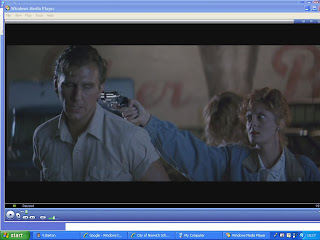Writer: Callie Khouri
Release Date: 12 July 1991 (UK)
Genre: Adventure/ Crime/ Drama/ Thriller
Producers: Mimi Polk, Callie Khouri (co-producer), Dean O'Brien (co-producer), Ridley Scott (producer)
Production Companies: MGM, Pathé Entertainment, Percy Main, Star Partners III Ltd. (in association with)
Distributors: MGM, NBC, Alamode Film, Chapel Distribution, Columbus Film,
Tobis Filmkunst, 20th Century Fox Home Entertainment, Argentina Video Home, Columbia Home Video, MGM Home Entertainment, MGM/UA Home Entertainment, United International Pictures, Warner Home Video
Distributors: MGM, NBC, Alamode Film, Chapel Distribution, Columbus Film,
Tobis Filmkunst, 20th Century Fox Home Entertainment, Argentina Video Home, Columbia Home Video, MGM Home Entertainment, MGM/UA Home Entertainment, United International Pictures, Warner Home Video
User Comment:
********** - Steve (ruth.boaz)
********** - Steve (ruth.boaz)
"It is clever, exciting, and funny and is shot in the middle of the breathtaking scenery of the American Southwest. However, the thing that makes it special is its illustration of pure friendship."
User Ratings:
Males- 7.2
Females-7.7
Under 18- 7.3
Males Under 18- 7.8
Females Under 18- 6.2
Aged 18-29 - 7.3
Males 18- 29 - 7.3
Females 18-29 - 7.8
The Film:
Thelma & Louise is set in Colorado, America. The country music and landscape are cultural signifiers. The two characters are very different from one another; this is evident from the first few minutes of the film. Louise has a job and is dressed smartly; Thelma on the other hand has messy hair and is quite scatty. She is less independent that Louise and is controlled by her vein, conceited and cheating husband.
At the beginning of the scene we looked at, Thelma & Louise are in a well lit bar with lots of people- this is quite a safe environment. However, it then cuts to the car park- a generic location for a Thriller; the mise en scene is dark and the car park is deserted. The only people in it are Thelma, who is drunk and unstable and the man she had been dancing with. The "friendly" man automatically creates suspicion and this is proved when he turns violent and tries to rape her. Louise steps in to help- acting as the hero character of the film; reiterating the contrast between the two. Louise is like the male figure; she carries a gun which is commonly thought to be a male weapon.
Their characters personalities are reflected through their costumes also: Thelma wears girly, feminine clothing. Whereas Louise wears more masculine things; her clothes suggest that she is stronger than Thelma, her behaviour seems to be similar to the male also. She shoots Harlem, which is a very irrational reaction: a reaction that is more likely to come from a man as they are recognised to be more irrational than women.
The roads they drive on are dark, wet and seem to be enclosing in on them; a generic feature of the Thriller genre. The light is broken up, suggesting that their lives have been broken up- now that they are on the run. They are surrounded by huge trucks which are male signifiers; their small car is vulnerable compared and it sort of personifies them. This also suggests that there is a male vs. female theme to the film.
Ridley Scott seems to be representing the midwestern males as misogynists throughout the film. For example: Daryl (Thelma's husband) and Harlem (Rapist) The attitude of men in the era that the film is set is that a woman's role is to gratify and serve men; the quote "we don't live in that kind of world Thelma" backs this. Scott turns this on it's head by using two women as main characters- this is quite uncommon and adds a twist to the Thriller genre.





Thelma and Louise: The first two paragraphs are too descriptive, you need to analyse how Thelma and Lousie are represented at the beginning of the film, Louise is a waitress and is thus serving others and has little economic power, whilst Thelma is in a flimsy dressing gown, has love hearts stuck to her fridge, she is also endeavouring to please her husband. The female world Thelma constructs in her house and in the clothes she wears (obviously to please her husband) is a trap. The sequence in the car park illustrates this point and that women like Thelma are considered as easy bait for men like Harlem......you need to make more of this point.
ReplyDeleteYour analysis improves in the latter section of your essay.
In a paternalistic society like ours, women are meant to be more irrational than men. This is illustrated by subjects like the sciences and maths considered to be rational and associaled with masculinity and thus are considered by some as superior to the arts subjects and some of the humanities.
ReplyDeleteSomething to think about when commentators on the media indicate that art, social sciences (sociology and psychology) and media studies are "soft" subjects (more female students are suspected to sign up to these subjects) whilst the sciences and maths are the "hard" subjects!!! Another form of misogyny!
Really!!!!